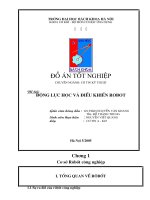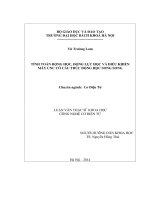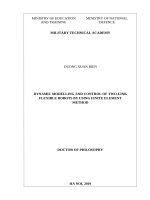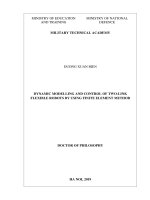Động lực học và điều khiển ô tô vehicle dynamics and control
Bạn đang xem bản rút gọn của tài liệu. Xem và tải ngay bản đầy đủ của tài liệu tại đây (21.57 MB, 485 trang )
Mechanical Engineering Series
Frederick
F.
Ling
Editor-in-Chief
Mechanical Engineering Series
J. Angeles, Fundamentals of Robotic Mechanical Systems:
Theory, Methods, and Algorithms, 2nd ed.
P. Basu, C. Kefa, and L. Jestin, Boilers and Burners: Design and Theory
J.M. Berthelot, Composite Materials:
Mechanical Behavior and Structural Analysis
I.J. Busch-Vishniac, Electromechanical Sensors and Actuators
J. Chakrabarty, Applied Plasticity
K.K. Choi and N.H. Kim, Structural Sensitivity Analysis and Optimization 1:
Linear Systems
K.K. Choi and N.H. Kim, Structural Sensitivity Analysis and Optimization 2:
Nonlinear Systems and Applications
G. Chryssolouris, Laser Machining: Theory and Practice
V.N. Constantinescu, Laminar Viscous Flow
G.A. Costello, Theory of Wire Rope, 2nd Ed.
K. Czolczynski, Rotordynamics of Gas-Lubricated Journal Bearing Systems
M.S. Darlow, Balancing of High-Speed Machinery
W. R. DeVries, Analysis of Material Removal Processes
J.F. Doyle, Nonlinear Analysis of Thin-Walled Structures: Statics,
Dynamics, and Stability
J.F. Doyle, Wave Propagation in Structures:
Spectral Analysis Using Fast Discrete Fourier Transforms, 2nd ed.
P.A. Engel, Structural Analysis of Printed Circuit Board Systems
A.C. Fischer-Cripps, Introduction to Contact Mechanics
A.C. Fischer-Cripps, Nanoindentations, 2nd ed.
J. García de Jalón and E. Bayo, Kinematic and Dynamic Simulation of
Multibody Systems: The Real-Time Challenge
W.K. Gawronski, Advanced Structural Dynamics and Active Control of
Structures
W.K. Gawronski, Dynamics and Control of Structures: A Modal Approach
(continued after index)
Rajesh Rajamani
Vehicle Dynamics and
Control
a
-
Springer
Rajesh Rajamani
University of Minnesota, USA
Editor-in-Chief
Frederick F. Ling
Earnest
F.
Gloyna Regents Chair Emeritus in Engineering
Department of Mechanical Engineering
The University of Texas at Austin
Austin, TX 78712-1063, USA
and
Distinguished William Howard Hart
Professor Emeritus
Department of Mechanical Engineering,
Aeronautical Engineering and Mechanics
Rensselaer Polytechnic Institute
Troy,
NY
12180-3590, USA
Vehicle Dynamics and Control by Rajesh Rajamani
ISBN 0-387-26396-9 e-ISBN 0-387-28823-6 Printed on acid-free paper.
ISBN 9780387263960
O
2006 Rajesh Rajamani
All rights reserved. This work may not be translated or copied in whole or in part without
the written permission of the publisher (Springer Science+Business Media, Inc., 233 Spring
Street, New York, NY 10013, USA), except for brief excerpts in connection with reviews or
scholarly analysis. Use in connection with any form of information storage and retrieval,
electronic adaptation, computer software, or by similar or dissimilar methodology now
known or hereafter developed is forbidden.
The use in this publication of trade names, trademarks, service marks and similar terms,
even if they are not identified as such, is not to be taken as an expression of opinion as to
whether or not they are subject to proprietary rights.
Printed in the United States of America.
SPIN 11012085
For
Priya
Mechanical Engineering Series
Frederick
F.
Ling
Editor-in-Chief
The Mechanical Engineering Series features graduate texts and research monographs to
address the need for information in contemporary mechanical engineering, including
areas of concentration of applied mechanics, biomechanics, computational mechanics,
dynamical systems and control, energetics, mechanics of materials, processing, produc-
tion systems, thermal science, and tribology.
Advisory BoardBeries Editors
Applied Mechanics
F.A. Leckie
University of California,
Santa Barbara
D. Gross
Technical University of Darmstadt
Biomechanics
Computational Mechanics
Dynamic Systems and ControU
Mechatronics
Energetics
Mechanics of Materials
Processing
Production Systems
Thermal Science
Tribology
V.C. Mow
Columbia University
H.T.
Yang
University of California,
Santa Barbara
D. Bryant
University of Texas at Austin
J.R. Welty
University of Oregon, Eugene
I. Finnie
University of California, Berkeley
K.K. Wang
Cornell University
G A. Klutke
Texas A&M University
A.E. Bergles
Rensselaer Polytechnic Institute
W.O. Winer
Georgia Institute of Technology
Series Preface
Mechanical engineering, and engineering discipline born of the needs of the indus-
trial revolution, is once again asked to do its substantial share in the call for indus-
trial renewal. The general call is urgent as we face profound issues of productivity
and competitiveness that require engineering solutions, among others. The Me-
chanical Engineering Series is a series featuring graduate texts and research mono-
graphs intended to address the need for information in contemporary areas of me-
chanical engineering.
The series is conceived as a comprehensive one that covers a broad range of
concentrations important to mechanical engineering graduate education and re-
search. We are fortunate to have a distinguished roster of consulting editors, each
an expert in one of the areas of concentration. The names of the consulting editors
are listed on page vi of this volume. The areas of concentration are applied me-
chanics, biomechanics, computational mechanics, dynamic systems and control,
energetics, mechanics of materials, processing, thermal science, and tribology.
As a research advisor to graduate students working on automotive
projects,
I
have frequently felt the need for a textbook that summarizes
common vehicle control systems and the dynamic models used in the
development of these control systems. While a few different textbooks on
ground vehicle dynamics are already available in the market, they do not
satisfy all the needs of a control systems engineer. A controls engineer
needs models that are both simple enough to use for control system design
but at the same time rich enough to capture all the essential features of the
dynamics. This book attempts to present such models and actual automotive
control systems from literature developed using these models.
The control system topics covered in the book include cruise control,
adaptive cruise control, anti-lock brake systems, automated lane keeping,
automated highway systems, yaw stability control, engine control, passive,
active and semi-active suspensions, tire models and tire-road friction
estimation. A special effort has been made to explain the several different
tire models commonly used in literature and to interpret them physically.
As the worldwide use of automobiles increases rapidly, it has become
ever more important to develop vehicles that optimize the use of highway
and fuel resources, provide safe and comfortable transportation and at the
same time have minimal impact on the environment. To meet these diverse
and often conflicting requirements, automobiles are increasingly relying on
electromechanical systems that employ sensors, actuators and feedback
control. It is hoped that this textbook will serve as a useful resource to
researchers who work on the development of such control systems, both in
the automotive industry and at universities. The book can also serve as a
textbook for a graduate level course on Vehicle Dynamics and Control.
An up-to-date errata for typographic and other errors found in the book
after it has been published will be maintained at the following web-site:
I
will be grateful for reports of such errors from readers.
Rajesh Rajamani
Minneapolis, Minnesota
May
2005
x
Contents
Dedication
Preface
Acknowledgments
1. INTRODUCTION
1.1
Driver Assistance Systems
1.2 Active Stability Control Systems
1.3 Ride Quality
1.4 Technologies for Addressing Traffic Congestion
1.4.1 Automated highway systems
1.4.2 Traffic friendly adaptive cruise control
1.4.3 Narrow tilt-controlled comuuter vehicles
1.5 Emissions and Fuel Economy
1.5.1 Hybrid electric vehicles
1 .5.2 Fuel cell vehicles
111
xix
xxi
1
2
2
4
5
6
6
7
9
10
11
v
xxv
ix
VEHICLE DYNAMICS
AND
CONTROL
References 11
2. LATERAL VEHICLE DYNAMICS 15
2.1 Lateral Systems Under Commercial Development
15
2.1.1 Lane departure warning 16
2.1.2 Lane keeping systems 17
2.1.3 Yaw stability control systems 18
2.2 Kinematic Model of Lateral Vehicle Motion
20
2.3 Bicycle Model of Lateral Vehicle Dynamics 27
2.4 Motion of Particle Relative to a rotating Frame
3 3
2.5 Dynamic Model in Terms of Error with Respect to Road 3
5
2.6 Dynamic Model in Terms of Yaw Rate and Slip Angle 3 9
2.7 From Body-Fixed to Global Coordinates
4 1
2.8 Road Model 43
2.9 Chapter Summary 46
Nomenclature 47
References 48
3.
STEERING CONTROL FOR AUTOMATED LANE KEEPING
5
1
3.1 State Feedback
5
1
3.2 Steady State Error from Dynamic Equations
5 5
3.3 Understanding Steady State Cornering
5
9
3.3.1 Steering angle for steady state cornering
5
9
3.3.2 Can the yaw angle error be zero?
64
xii
Contents
3.3.3 Is non-zero yaw error a concern?
3.4 Consideration of Varying Longitudinal Velocity
3.5 Output Feedback
3.6 Unity feedback Loop System
3.7 Loop Analysis with a Proportional Controller
3.8 Loop Analysis with a Lead Compensator
3.9 Simulation of Performance with Lead Compensator
3.10 Analysis if Closed-Loop Performance
3.10.1 Performance variation with vehicle speed
3.10.2 Performance variation with sensor location
86
3.1 1 Compensator Design with Look-Ahead Sensor Measurement 88
3.12 Chapter Summary 90
Nomenclature 90
References 92
4. LONGITUDINAL VEHICLE DYNAMICS 95
4.1 Longitudinal Vehicle Dynamics 95
4.1.1 Aerodynamic drag force 97
4.1.2 Longitudinal tire force 99
4.1.3 Why does longitudinal tire force depend on slip? 101
4.1.4 Rolling resistance 104
4.1.5 Calculation of normal tire forces
106
4.1.6 Calculation of effective tire radius
108
xiii
VEHICLE DYNAMICS AND CONTROL
4.2 Driveline Dynamics 111
4.2.1 Torque converter 112
4.2.2 Transmission dynamics 114
4.2.3 Engine dynamics 116
4.2.4 Wheel dynamics 118
4.3 Chapter Summary
120
Nomenclature 120
References 122
5. INTRODUCTION TO LONGITUDINAL CONTROL 123
5.1 Introduction 123
5.1.1 Adaptive cruise control 124
5.1.2 Collision avoidance 125
5.1.3 Automated highway systems 125
5.2 Benefits of Longitudinal Automation
126
5.3 Cruise Control 128
5.4 Upper Level Controller for Cruise Control
130
5.5 Lower Level for Cruise Control 133
5.5.1 Engine torque calculation for desired acceleration
134
5.5.2 Engine control 137
5.6 Anti-Lock Brake Systems 137
5.6.1 Motivation 137
5.6.2 ABS functions 141
xiv
Contents
5.6.3 Deceleration threshold based algorithms
142
5.6.4 Other logic based ABS control systems
146
5.6.5 Recent research publications on ABS
148
5.7 Chapter Summary 148
Nomenclature 149
References 150
6. ADAPTIVE CRUISE CONTROL 153
6.1 Introduction 153
6.2 Vehicle Following Specifications 155
6.3 Control Architecture 156
6.4 String Stability 158
6.5 Autonomous Control with Constant Spacing
159
6.6 Autonomous Control with the Constant Time-Gap Policy 162
6.6.1 String stability of the CTG spacing policy
164
6.6.2 Typical delay values 167
6.7 Transitional Trajectories 169
6.7.1 The need for a transitional controller
169
6.7.2 Transitional controller design through
R
-
R
diagrams 172
6.8 Lower Level Controller 178
6.9 Chapter Summary 180
Nomenclature 180
References 18 1
xv
VEHICLE DYNAMICS AND CONTROL
Appendix
6.A
183
7. LONGITUDINAL CONTROL FOR VEHICLE PLATOONS 187
7.1 Automated Highway Systems 187
7.2 Vehicle Control on Automated Highway Systems 188
7.3 Longitudinal Control Architecture 189
7.4 Vehicle Following Specifications 191
7.5 Background on Norms of Signals and Systems 193
7.5.1 Norms of signals 193
7.5.2 System norms 194
7.5.3 Use of system norms to study signal amplification 195
7.6 Design Approach for Ensuring String Stability 198
7.7
Constant Spacing with Autonomous Control
200
7.8 Constant Spacing with Wireless Communication 203
7.9 Experimental Results 206
7.10 Lower Level Controller 208
7.1 1 Adaptive Controller for Unknown Vehicle Parameters 209
7.1 1.1 Redefined notation 209
7.1 1.2 Adaptive controller
21 1
7.12 Chapter Summary 214
Nomenclature 215
References 216
Appendix 7.A 218
xvi
xi
Contents
8. ELECTRONIC STABILITY CONTROL 22 1
8.1 Introduction 22 1
8.1.1 The functioning of a stability control system
22 1
8.1.2 Systems developed by automotive manufacturers 223
8.1.3 Types of stability control systems 223
8.2 Differential Braking Systems 224
8.2.1 Vehicle model 224
8.2.2 Control architecture 229
8.2.3 Desired yaw rate 230
8.2.4 Desired side-slip angle 23 1
8.2.5 Upper bounded values of target yaw rate and slip angle 233
8.2.6 Upper controller design 235
8.2.7 Lower Controller design
23 8
8.3 Steer-By-Wire Systems 240
8.3.1 Introduction 240
8.3.2 Choice of output for decoupling
24 1
8.3.3 Controller design 244
8.4 Independent All Wheel Drive Torque Distribution
247
8.4.1 Traditional four wheel drive systems
247
8.4.2 Torque transfer between left and right wheels
248
8.4.3 Active control of torque transfer to all wheels 249
8.5 Chapter Summary 25 1
xvii
VEHICLE DYNAMICS AND CONTROL
Nomeclature 252
References 255
9. MEAN VALUE MODELING OF SI AND DIESEL ENGINES 257
9.1 SI Engine Model Using Parametric Equations 25
8
9.1.1 Engine rotational dynamics 259
9.1.2 Indicated combustion torque 260
9.1.3 Friction and pumping losses 26 1
9.1.4 Manifold pressure equation 262
9.1.5 Outflow rate from intake manifold 263
9.1.6 Inflow rate into intake manifold 263
9.2 SI Engine Model Using Look-Up Maps
265
9.2.1 Introduction to engine maps
266
9.2.2 Second order engine model using engine maps 270
9.2.3 First order engine model using engine maps 27 1
9.3 Introduction to Turbocharged Diesel Engine Maps 27 3
9.4 Mean Value Modeling of Turbocharged Diesel Engines 274
9.4.1 Intake manifold dynamics 275
9.4.2 Exhaust manifold dynamics 275
9.4.3 Turbocharger dynamics 276
9.4.4 Engine crankshaft dynamics 277
9.4.5 Control system objectives
27
8
9.5 Lower Level Controller with SI Engines
279
xviii
Contents
9.6 Chapter Summary
Nomenclature
References
10. DESIGN AND ANALYSIS OF PASSIVE AUTOMOTIVE
SUSPENSIONS
10.1 Introduction to Automotive Suspensions
10.1.1 Full, half and quarter car suspension models
10.1.2 Suspension functions
10.1.3 Dependent and independent suspensions
10.2 Modal Decoupling
10.3 Performance Variables for a Quarter Car Suspension
10.4 Natural Frequencies and Mode Shapes for the Quarter Car
10.5 Approximate Transfer Functions Using Decoupling
10.6 Analysis of Vibrations in the Sprung Mass Mode
10.7 Analysis of Vibrations in the Unsprung Mass Mode
10.8 Verification Using the Complete Quarter Model
10.8.1 Verification of the influence of suspension stiffness
10.8.2 Verification of the influence of suspension damping
10.8.3 Verification of the influence of tire stiffness
10.9 Half-Car and Full-Car Suspension Models
10.10 Chapter Summary
Nomenclature
References
xix
VEHICLE DYNAMICS AND CONTROL
1 1. ACTIVE AUTOMOTIVE SUSPENSIONS 325
11.1 Introduction 325
11.2 Active Control: Trade-offs and Limitations 328
1 1.2.1 Transfer functions of interest 328
1 1.2.2 Use of the LQR Formulation and its relation to
H2
Optimal Control 328
11.2.3 LQR formulation for active suspension design
330
11.2.4 Performance studies of the LQR controller 332
1 1.3 Active System Asymptotes 339
1 1.4 Invariant Points and Their Influence on the Suspension
Problem 34 1
1
1.5 Analysis of Trade-offs Using Invariant Points 343
1 1.5.1 Ride quality1 road holding trade-offs 344
11 S.2 Ride quality1 rattle space trade-offs
345
1 1.6 Conclusions on Achievable Active System Performance
346
11.7 Performanceof a Simple Velocity Feedback Controller 348
11.8 Hydraulic Actuators for Active Suspensions
350
1 1.9 Chapter Summary 352
Nomenclature 353
References 354
12. SEMI-ACTIVE SUSPENSIONS 357
12.1 Introduction 357
12.2 Semi-Active Suspension Model 359
xx
Contents
12.3 Theoretical Results: Optimal Semi-Active Suspensions
12.3.1 Problem formulation
12.3.2 Problem definition
12.3.3 Optimal solution with no constraints on damping
12.3.4 Optimal solution in the presence of constraints
12.4 Interpretation of the Optimal Semi-Active Control Law
12.5 Simulation Results
12.6 Calculation of Transfer Function Plots with Semi-Active
Suspensions
12.7 Performance of Semi-Active Suspension Systems
12.7.1 Moderately weighted ride quality
12.7.2 Sky hook damping
12.8 Chapter Summary
Nomenclature
References
13. LATERAL AND LONGITUDINAL TIRE FORCES
13.1 Tire Forces
13.2 Tire Structure
13.3 Longitudinal Tire Force at Small Slip Ratios
13.4 Lateral Tire Force at Small Slip Angles
13.5 Introduction to the Magic Formula Tire Model
13.6 Development of Lateral Tire Model for Uniform Normal
Force Distribution
xxi
VEHICLE DYNAMICS AND CONTROL
13.6.1 Lateral forces at small slip angles 402
13.6.2 Lateral forces at large slip angles 405
13.7 Development of Lateral Tire Model for Parabolic Normal
Pressure Distribution 409
13.8 Combined Lateral and Longitudinal Tire Force Generation
4 17
13.9 The Magic Formula Tire Model
42 1
13.10 Dugoff's Tire Model 425
13.10.1 Introduction 425
13.10.2 Model equations 426
13.10.3 Friction Circle Interpretation of Dugoff's Model
427
13.1
1
Dynamic Tire Model
429
13.12 Chapter Summary 430
Nomenclature 430
References 432
14. TIRE-ROAD FRICTION MEASUREMENT ON HIGHWAY
VEHICLES 433
14.1 Introduction 433
14.1.1 Definition of tire-road friction coefficient 433
14.1.2 Benefits of tire-road friction estimation
434
14.1.3 Review of results on tire-road friction coefficient
estimation 435
14.1.4 Review of results on slip-slope based approach to friction
estimation 436
14.2 Longitudinal Vehicle Dynamics and Tire Model for Friction
Estimation 438
xxii
Contents
14.2.1 Vehicle longitudinal dynamics
14.2.2 Determination of the normal force
14.2.3 Tire model
14.2.4 Friction coefficient estimation for both traction
and braking
14.3 Summary of Longitudinal Friction identification Approach
14.4 Identification Algorithm Design
14.4.1 Recursive least-squares
(RLS)
identification
14.4.2 RLS with gain switching
14.4.3 Conditions for parameter updates
14.5 Estimation of Accelerometer Bias
14.6 Experimental Results
14.6.1 System hardware and software
14.6.2 Tests on dry concrete surface
14.6.3 Tests on concrete surface with loose snow covering
14.6.4 Tests on surface consisting of two different friction
levels
14.6.5 Hard braking test
14.7 Chapter Summary
Nomenclature
References
Index
xxiii
Acknowledgments
I
am deeply grateful to Professor Karl Hedrick for introducing me to the
field of Vehicle Dynamics and Control and for being my mentor when
I
started working in this field. My initial research with him during my
doctoral studies has continued to influence my work.
I
am also grateful to
Professor Max Donath at the University of Minnesota for his immense
contribution in helping me establish a strong research program in this field.
I
would also like to express my gratitude to my dear friend Professor
Darbha Swaroop. The chapters on longitudinal control in this book are
strongly influenced by his research results.
I
have had innumerable
discussions with him over the years and have benefited greatly from his
generosity and willingness to share his knowledge.
Several people have played a key role in making this book a reality.
I
am
grateful to Serdar Sezen for highly improving many of my earlier drawings
for this book and making them so much more clearer and professional.
I
would also like to thank Vibhor Bageshwar, Jin-Oh Hahn and Neng
Piyabongkarn for reviewing several chapters of this book and offering their
comments.
I
am grateful to Lee Alexander who has worked with me on
several research projects in the field of vehicle dynamics and contributed to
my learning.
I
would like to thank my parents Vanaja and Ramamurty Rajamani for
their love and confidence in me. Finally,
I
would like to thank my wife
Priya. But for her persistent encouragement and insistence,
I
might never
have returned from a job in industry to a life in academics and this book
would probably have never been written.
Rajesh Rajamani
Minneapolis, Minnesota
May
2005
Chapter
1
INTRODUCTION
The use of automobiles is increasing worldwide. In 1970, 30 million
vehicles were produced and 246 million vehicles were registered worldwide.
By 2005,
65
million vehicles are expected to be produced and more than 800
million vehicles could be registered (Powers and Nicastri, 2000).
The increasing worldwide use of automobiles has motivated the need to
develop vehicles that optimize the use of highway and fuel resources,
provide safe and comfortable transportation and at the same time have
minimal impact on the environment. It is a great challenge to develop
vehicles that can satisfy these diverse and often conflicting requirements. To
meet this challenge, automobiles are increasingly relying on
electromechanical sub-systems that employ sensors, actuators and feedback
control. Advances in solid state electronics, sensors, computer technology
and control systems during the last two decades have also played an enabling
role in promoting this trend.
This chapter provides an overview of some of the major
electromechanical feedback control systems under development in the
automotive industry and in research laboratories. The following sections in
the chapter describe developments related to each of the following five
topics:
a) driver assistance systems
b) active stability control systems
c) ride quality improvement
d) traffic congestion solutions and
e) fuel economy and vehicle emissions
Chapter
1
DRIVER ASSISTANCE SYSTEMS
On average, one person dies every minute somewhere in the world due to
a car crash (Powers and Nicastri, 2000). In addition to the emotional toll of
car crashes, their actual costs in damages equaled 3% of the world GDP and
totaled nearly one trillion dollars in 2000. Data from the National Highway
Safety Transportation Safety Association (NHTSA) show that 6.335 million
accidents (with 37,081 fatalities) occurred on US highways in 1998
(NHTSA, 1999). Data also indicates that, while a variety of factors
contribute to accidents, human error accounts for over 90% of all accidents
(United States DOT Report, 1992).
A variety of driver assistance systems are being developed by automotive
manufacturers to automate mundane driving operations, reduce driver
burden and thus reduce highway accidents. Examples of such driver
assistance systems under development include
a)
collision avoidance systems which automatically detect slower
moving preceding vehicles and provide warning and brake assist to
the driver
b)
adaptive cruise control (ACC) systems which are enhanced cruise
control systems and enable preceding vehicles to be followed
automatically at a safe distance
c) lane departure warning systems
d)
lane keeping systems which automate steering on straight roads
e)
vision enhancement/ night vision systems
f)
driver condition monitoring systems which detect and provide
warning for driver drowsiness, as well as for obstacles and
pedestrians
g) safety event recorders and automatic collision and severity
notification systems
These technologies will help reduce driver burden and make drivers less
likely to be involved in accidents. This can also help reduce the resultant
traffic congestion that accidents tend to cause.
Collision avoidance and adaptive cruise control systems are discussed in
great depth in Chapters
5
and 6 of this book. Lane keeping systems are
discussed in great detail in Chapter 3.
ACTIVE STABILITY CONTROL SYSTEMS
Vehicle stability control systems that prevent vehicles from spinning,
drifting out and rolling over have been developed and recently









